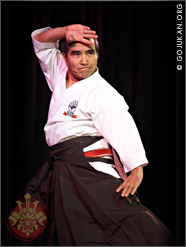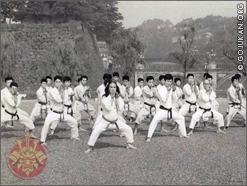Gōjū-ryū Kata
剛柔流形
Page is under Construction
Resources:
None at Present
Options:
___

Kata is a pattern of movements which contains a series of logical and practical attacking and blocking techniques. In each kata there are certain set or predetermined movements which the student can practice alone, without a partner. These kata have been created by previous masters after many years of research, training, and actual combat experience.
The applications of the techniques in these kata have evolved from and have been tested in actual combat. Bunkai refers to the break-down of a kata , to analyze the moves hidden within such as strikes, locks, throws or pressure point strikes. There are several level of bunkai and there is no single, correct bunkai for a given move. As one advances up the ranks, one gains a better and deeper understanding of the katas and their bunkai. It should be known that secret principles of Gōjū-Ryū exist in the kata. In this way each kata has been improved and refined, and has evolved into the kata we practice today.

Because of the time and the katas complex evolution it is impossible to trace the exact development that the kata underwent, but it is known that the old masters studied the combative techniques and movements in the fighting between animal and animal, animal and man, and man-to-man. They also studied the physiology of the human body and its relationship to combat, taking into account such factors as the circulation of the blood in a twenty-four hour day, the vulnerability of the vital points in relation to the time of day, and other cyclic laws of nature such as the rising and setting of the sun, and the rise and fall of the tides. All of these elements are incorporated into the kata.

The purpose for developing kata also varied with the times and with the people who developed them. For example, in China over 1600 years ago kata was developed and practiced for the purpose of self-defense, whereas the Buddhist monks would practice kata for the purpose of strengthening the spirit as well as the body.
One can learn the katas in as little as a day but it can take several years to master a kata and learn its secrets. The true meaning and spirit of karate are embedded in the kata and only by the practice of kata can we come to understand them. For this reason, if we change or simplify the kata either to accommodate the beginner or for tournament purposes, then we also will have lost the true meaning and spirit of karate.
In karate there is no first attack. Every kata begins with a defensive movement, which exemplifies this spirit. Not only is there no first attack, but the best defense is to avoid the fight altogether. That is why it is said that karate is the art of a wise man.
To practice the kata correctly every movement must be repeated over and over again. Only through constant repetition can the techniques become reflex action. Kata practice is a lifetime of dedication under the guidance of a knowledgeable and authentic teacher. An important aspect of kata is that it can be practiced alone, anytime and anywhere. When kata is performed by a well-trained person, its dynamic power and beauty of movement become almost aesthetic in quality.
Elements of Kata:
There are multiple key elements of karate. Some are:
- Rhythm & Timing; a kata, no matter what Ryū-ha or Kai-ha must have a certain rhythm. That being slow, part slow, fast, part fast. Those watching, as well as the performer, must be able to differentiate the difference in speed and purpose.
- Balance
- Power
- Balance and strength
- Grace
- Breathing control
- Simplicity - Complexity
- Visualization of technique - Focus
- Embusen
- Zanshin
Options:
Color Key Code:
 - 入門 - Nyūmon (Kyu 0)
- 入門 - Nyūmon (Kyu 0) - 初級 - Shokyū (Kyu 10-8)
- 初級 - Shokyū (Kyu 10-8) - 中級 - Chūkyū (Kyu 7-4)
- 中級 - Chūkyū (Kyu 7-4) - 上級 - Jōkyū (Kyu 3-1)
- 上級 - Jōkyū (Kyu 3-1) - 初伝 - Shoden (Dan 1 & 2)
- 初伝 - Shoden (Dan 1 & 2) - 中伝 - Chūden (Dan 3 & 4)
- 中伝 - Chūden (Dan 3 & 4) - 奥伝 - Okuden (Dan 5 & 6)
- 奥伝 - Okuden (Dan 5 & 6) - 口伝 - Kuden (Dan 7)
- 口伝 - Kuden (Dan 7)